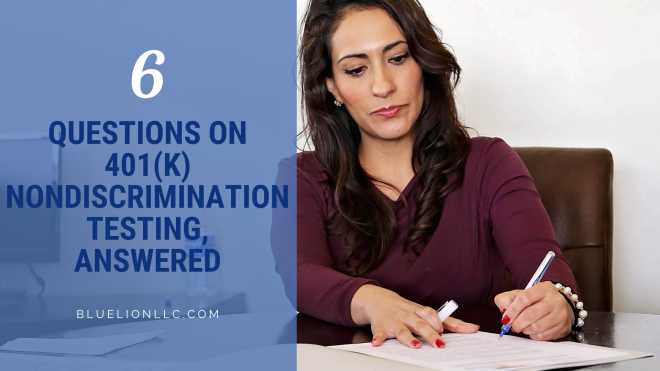
Suppose you own a young business or recently introduced a retirement plan to your employee benefits package. In that case, you might have heard about something called 401(k) nondiscrimination testing—and wondering what the heck it is.
Also known as 401(k) coverage testing, this is an annual IRS review used to prove a company does not discriminate in favor of highly-compensated employees (HCEs). The test also ensures your plan covers a sufficient number of non-highly compensated employees (NHCEs).
Like Form 5500 and audit requirements, employers need to understand the fundamentals of the coverage test to ensure your plan is compliant and avoid mistakes. Failing the test requires fixing it, which can be extremely costly and time-consuming. (We’ll explain more on the penalties and consequences a bit later.)
To make sure you know what to expect and what information you’ll need, we’ve answered the most critical questions about 401(k) nondiscrimination testing. Keep reading to prepare your business for this year’s test.
1. Who completes the 401(k) nondiscrimination test?
Typically your plan provider completes the 401(k) nondiscrimination test for you. Keep in mind, though, that you will need to provide them with complete and accurate information. You must know the basics to ensure you don’t miss important information, potentially triggering an inaccurate test result.
2. How is 401(k) coverage measured?
The test looks at all employee and employer contributions made throughout the year, including:
- Employee salary deferrals
- Employer matches
- Profit-sharing
The result must satisfy either the ratio percentage or the average benefit test. The ratio percentage is the most common method and must equal or exceed 70%. It is calculated using the equation:
(# of “benefitting” NHCEs / # of “eligible” NHCEs) / (# of “benefitting” HCEs / # of “eligible” HCEs)
3. Which employees are eligible?
Employees who met the applicable contribution’s age and service eligibility requirements for the year are eligible, excluding:
- Union employees
- Non-resident aliens with no U.S. income
- Terminated employees who worked less than 500 hours in the year
4. Which employees are benefitting?
This refers to employees who benefit from the contribution, meaning they:
- Have the right to make 401(k) salary deferrals and/or receive matching contributions.
- Receive an allocation from a profit-sharing contribution.
Employees who do not benefit include:
- Employees excluded by the plan document (e.g., hourly, contracted)
- Employees of a controlled group member that does not co-sponsor the plan
- Employees who failed to meet the contribution’s allocation conditions (e.g., terminated before year-end, worked less than 1,000 hours in the year)
If you’re unsure of which employees are eligible and benefitting, simply report every employee who received $1 or more in compensation during the year to your plan provider. They should inform you if they have questions about an employee’s status.
5. What is a controlled group, and is your company part of one?
The IRS controlled group rules consider two or more employers with common ownership as a single employer for 401(k) nondiscrimination testing. These rules often require all members of a controlled group to cover their employees with the same 401(k) plan to pass annual coverage testing.
Controlled group rules exist to prevent employers from subdividing their company into separate companies, using one to employ HCEs and the other to employ NHCEs. This would allow companies to discriminate in favor of HCEs.
If your company is part of a controlled group, you’ll need to give your plan provider the employee information for all members of your controlled group. The IRS considers your company part of a controlled group when one of these relationships exists:
- Parent-subsidiary Relationship: When one company owns 80% or more of another company
- Brother-sister Relationship: When two companies meet two thresholds.
- Common Ownership: 5 or fewer individuals own 80% or more of each company; and
- Identical Ownership: The common owners have identical ownership of more than 50%
6. What are the consequences of a failed coverage test, and how can you fix it?
If you fail a coverage test, you must adopt a corrective amendment within 9.5 months following the close of the plan year in which the failure occurred to expand plan coverage retroactively. You’ll need to:
- Conduct an independent review to determine if HCEs and NHCEs are properly classified; and
- Make qualified nonelective contributions (QNECs) to new NHECs to make up for their missed deferral opportunities, as well as any missed employer contributions.
The IRS considers any coverage failure not corrected within 9.5 months to be a demographic failure. This can only be voluntarily fixed using the IRS’ Voluntary Compliance Program (VCP). At this point, employers face fines.
Employers could be in even bigger trouble if a 401(k) coverage failure is not corrected at all. This can result in plan disqualification if the issue is found during an IRS audit. In this case, the plan’s trust loses its tax-exempt status and becomes a nonexempt trust. Disqualification affects:
- Employees
- Employer
- The plan’s trust
Did the thought of plan disqualification give you a sinking feeling? We don’t blame you! But don’t stress—you can avoid failing the 401(k) nondiscrimination test by communicating with your plan provider and ensuring they have all the information they need to complete the test accurately.
Having a basic understanding of the testing rules helps, but we know it can still be overwhelming. If you would like more guidance to make sure your employees are correctly classified, contact BlueLion today at 603-818-4131 or info@bluelionllc.com.
The information on this website, including its newsletters, is not, nor is it intended to be legal advice. You should contact an attorney or HR specialist for advice on your individual situation.


